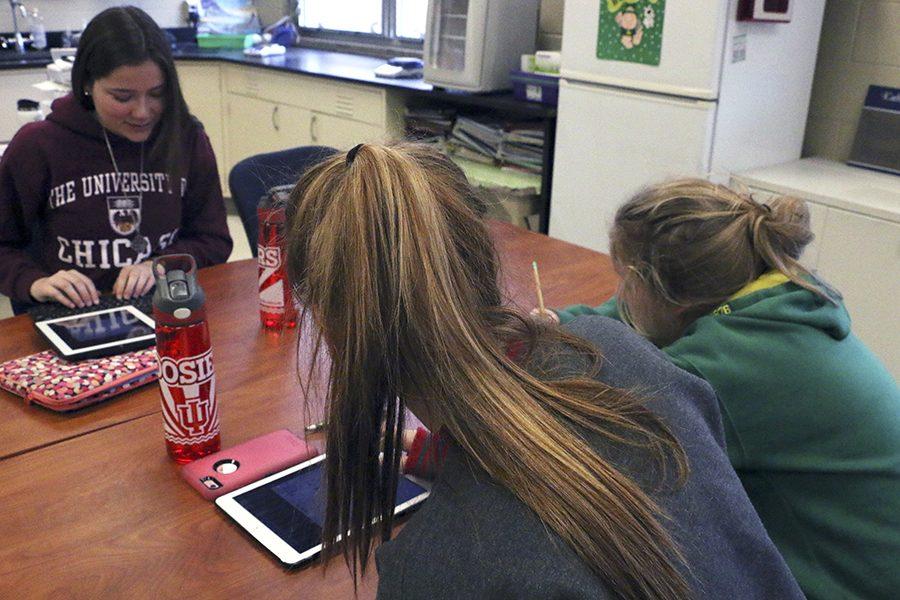Campus works to become greener
Annual Earth Day celebration on April 22 approaches
Seniors Emily Getz, Katie Hoffman and Kelly Barry take notes in AP Environmental Science. AP Environmental provides another opportuinity for students to learn new ways to preserve and enhance the environment.
As the annual Earth Day celebration approaches on April 22, this school doesn’t celebrate the environment merely once a year, but does so every day.
“The school started five years ago to make a conscious effort to reduce our carbon footprint as much as possible,” Mr. Rolly Landeros, chief information officer, said. For instance, the school partnered with Johnson Melloh to install solar panels on the Student Life Center, he said.
Other projects are underway to further help the environment. “We are currently replacing all of the thermostats in the entire campus to allow us to monitor every single location for proper cooling and heating and to not waste excessive heating and cooling when it’s not necessary,” Landeros said.
Effort to change
The school has attempted to determine its largest source of waste and decrease that source in the future, Landeros said. Technology can assist in this. The school uses PaperCut, an application that monitors pages of paper printed relative to trees cut. Eight thousand pages represents one tree, Landeros said.
Additionally, the school attempts to plant two trees on campus whenever one tree is cut, Landeros said.
For times that paper is used in classrooms, students and teachers can dispose of unnecessary pages in recycling bins distributed throughout the building.
Environmental club to the rescue
“Right now we have recycling bins in most if not all of the classrooms,” sophomore Sarah Prazeau said. Prazeau is a member of the Environmental Club, which works to spread awareness of recycling and the environment.
Junior Katherine Urasky serves as president of the club. In the future, club members hope to use a greenhouse to plant food, which could then be donated to a soup kitchen, she said. The club is also organizing a compost project.
One of the club’s tasks includes emptying the school’s blue recycle bins. “Please do not put food in our recycling bins,” Urasky said. Besides this, Urasky encourages students and faculty to utilize the bins.
“If you notice that you’re drinking a plastic bottle, throw it in recycling,” Junior Kelsey Deemer, member of the Environmental Club, said. She has noticed that students follow these directions. “Our bins fill up relatively quickly,” she said.
Students really care
“I think that students generally care and want to do the right thing,” said Mrs. Jennifer Alexander, science teacher and Environmental Club sponsor. To assist, students should reduce use of paper and plastic products, Alexander said.
“Technology can definitely be used to help,” Landeros said. Students can request to submit assignments digitally if possible, or teachers can distribute electronic resources rather than print large packets, he said.
Caring for the environment does not need to take much effort. It can be as simple as taking two seconds to think about recycling, Prazeau said. “It’s a lot easier than you think it is,” she said.
“If you see trash, pick it up,” Landeros said. “Make our world a better place,” he said.
“Look around and realize that you actually have an effect on the community around you,” Urasky said.
Science indicates that in the future, we will suffer the effects of a poor environment. “There is time, but that doesn’t mean we should waste the time,” Alexander said. “It’s everybody’s responsibility, not just (for) clubs or adults.”
“The earth does so much for us,” Deemer said. Every person can and should make an effort to help the environment, she said.
Landeros is reminded of Jen Maginot’s quote to be kind, he said. “We should always be kind to Mother Earth.”







